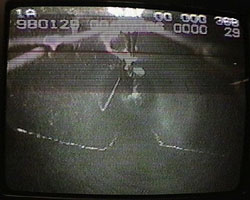
|

|
|
|
©
Per Olof Hulth
|
|
|
Four
days after deployment, ice has formed around the module,
and a crack appears in the wall.
|
|
|
|

A
literary essay about AMANDA by Francis Halzen
page 10
Neutrino
oscillation should prove an equally intriguing and elusive
quarry. If neutrinos, contrary to current assumptions, are
relatively massive—say, between ten and fourteen electron
volts—they should oscillate fairly quickly. In that case,
even short-range tests, such as the 450-mile neutrino beam
that investigators at Fermi National Accelerator Laboratory
in Batavia, Illinois, are planning to aim at a neutrino detector
in Minnesota, should confirm oscillations. (As it happens,
the Fermilab beam passes right under my office in Madison.)
If neutrinos have almost no mass, it may take a detector as
large as ours, observing neutrinos that come from as far as
10 billion light-years away, to see oscillations. Some of
us have even been dreaming about sending a beam from Fermilab
to the South Pole: a 6,000-mile trip that may be just long
enough to reveal oscillations, if neutrinos have the mass
that the Super-K data suggest.
In the next five years we plan to sink seventy more strings
of photomultipliers, enabling the telescope to keep watch
over a full cubic kilometer of ice. Even then, in some ways,
our telescope will be a pretty crude instrument. Compared
to a standard optical telescope, its resolution is a joke:
as of this writing, it is accurate only to within two degrees
of arc—roughly four times the diameter of the full moon—though
we hope to cut that margin in half. AMANDA’S size alone
will give it tremendous power, of course, enabling it to detect
gamma-ray bursts and super-massive black holes several times
a year. And yet, spectacular though they are, such cosmic
light shows should prove no more than opening acts for the
main event—whatever that may be.
IN
THE PAST, every time astronomers have set their sights on
a new wavelength, they have discovered more than they expected.
Ricardo Giacconi built an X-ray detector to study solar X
rays reflected by the moon, and found neutron and binary stars
instead. Karl G. Jansky built an antenna to study short-wave
radio interference and discovered radio galaxies. Arno A.
Penzias and Robert W. Wilson focused on microwaves and stumbled
on the cosmic background radiation, confirming the existence
of the big bang. In each case, nature was more imaginative
than the people who probed it. If, after nearly twenty years
of working on AMANDA, we only discover what we have set out
to discover, it will be, in many ways, the most disappointing
result imaginable. As Edward W. "Rocky" Kolb, an
astrophysicist at Fermilab, put it: "With neutrino astronomy,
the real surprise would be that there were no surprises."
|
